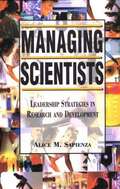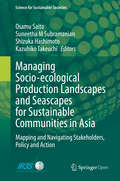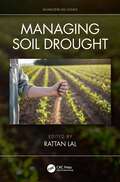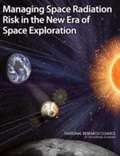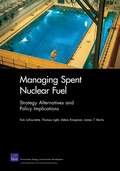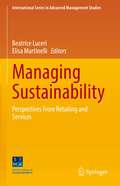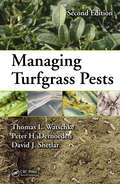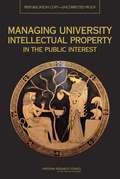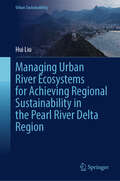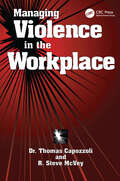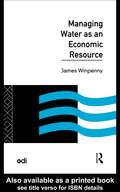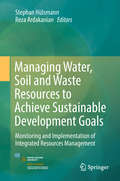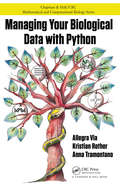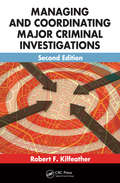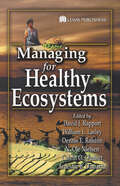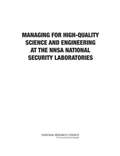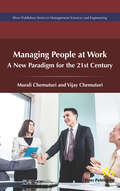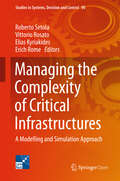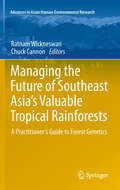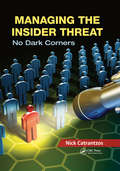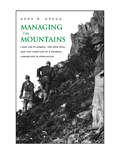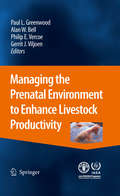- Table View
- List View
Managing Scientists: Leadership Strategies in Research and Development
by Alice M. SapienzaIn today's climate of enormous scientific and technological competition, it is more crucial than ever that scientists' involvement in research and development be managed well.
Managing Social Responsibility: Functional Strategies, Decisions and Practices (CSR, Sustainability, Ethics & Governance)
by Duygu TurkerThis book explores how business organizations incorporate socially responsible approaches into their diverse functional strategies, decisions, and practices. It analyzes the nature and dynamics of each function as well as their specific characteristics in the formulation of sustainable strategies and decisions. As such, the book comprehensively aligns recent approaches on social responsibility and sustainability with real-world practices.By viewing corporate social responsibility (CSR) as the catalyzer of United Nations’ Sustainable Development Goals (SDGs) at the organizational level, this book introduces readers to the latest thinking and best practices towards the accomplishment of those overarching goals of humanity. Cases and examples from production, marketing, finance, accounting, human resources, and all parts of the enterprise make this book a valuable resource for scholars, students, up-and-coming managers and practitioners alike.
Managing Socio-ecological Production Landscapes and Seascapes for Sustainable Communities in Asia: Mapping and Navigating Stakeholders, Policy and Action (Science for Sustainable Societies)
by Osamu Saito Kazuhiko Takeuchi Suneetha M Subramanian Shizuka HashimotoThis open access book presents up-to-date analyses of community-based approaches to sustainable resource management of SEPLS (socio-ecological production landscapes and seascapes) in areas where a harmonious relationship between the natural environment and the people who inhabit it is essential to ensure community and environmental well-being as well as to build resilience in the ecosystems that support this well-being. Understanding SEPLS and the forces of change that can weaken their resilience requires the integration of knowledge across a wide range of academic disciplines as well as from indigenous knowledge and experience. Moreover, given the wide variation in the socio-ecological makeup of SEPLS around the globe, as well as in their political and economic contexts, individual communities will be at the forefront of developing the measures appropriate for their unique circumstances. This in turn requires robust communication systems and broad participatory approaches.Sustainability science (SuS) research is highly integrated, participatory and solutions driven, and as such is well suited to the study of SEPLS. Through case studies, literature reviews and SuS analyses, the book explores various approaches to stakeholder participation, policy development and appropriate action for the future of SEPLS. It provides communities, researchers and decision-makers at various levels with new tools and strategies for exploring scenarios and creating future visions for sustainable societies.
Managing Soil Drought (ISSN)
by Rattan LalGlobal drylands, covering over 40% of Earth’s land surface, are important among worldwide ecoregions and support large human and livestock populations. However, these ecologically sensitive ecoregions are undergoing a rapid transformation resulting from climate change, socioeconomic and political factors, increases in population, and ever-growing demands for goods and services.Managing Soil Drought addresses basic processes and provides specific case studies throughout covering the protection, restoration, and sustainable management goals of global drylands under changing and harsh climatic conditions, including fragile and vulnerable ecosystems. The book is written by numerous researchers, academicians, practitioners, advocates, land managers, and policymakers involved in bringing about transformation in these regions important to human and nature. It includes information on basic strategies of sustainable management of global drylands aimed at improving water use efficiency through choosing appropriate species, developing new varieties, using organic and inorganic amendments, and scaling up innovative farming systems.This volume in the Advances in Soil Sciences series is an essential read for development organizations and policymakers involved in improving crop productivity and sustainability in drought-prone regions; students, researchers, and academicians interested in sustainable management of water resources; and those involved in emerging concepts of regenerative agriculture, agroecology, and conservation agriculture.
Managing Space Radiation Risk in the New Era of Space Exploration
by National Research Council of the National AcademiesAs part of the Vision for Space Exploration (VSE), NASA is planning for humans to revisit the Moon and someday go to Mars. An important consideration in this effort is protection against the exposure to space radiation. That radiation might result in severe long-term health consequences for astronauts on such missions if they are not adequately shielded. To help with these concerns, NASA asked the NRC to further the understanding of the risks of space radiation, to evaluate radiation shielding requirements, and recommend a strategic plan for developing appropriate mitigation capabilities. This book presents an assessment of current knowledge of the radiation environment; an examination of the effects of radiation on biological systems and mission equipment; an analysis of current plans for radiation protection; and a strategy for mitigating the risks to VSE astronauts.
Managing Spent Nuclear Fuel
by Tom Latourrette Thomas Light James T. Bartis Debra KnopmanNuclear power is receiving renewed interest because of its low greenhouse gas emissions. However, if nuclear power is to be sustainable option for the United States, methods for managing spent fuel that meet stringent safety and environmental standards must be implemented. This report examines technical and institutional approaches to spent fuel management and highlights policy implications of pursuing alternative strategies.
Managing Sustainability: Perspectives From Retailing and Services (International Series in Advanced Management Studies)
by Beatrice Luceri Elisa MartinelliCompanies and policy makers are prioritizing environmental, social, and governance goals as part of their strategies. Academic research has started to focus on these issues, but many important matters require deeper investigation and reflection, especially in specific sectors. This book focuses on the sustainability issues within the retailing and services sectors. Starting the discussion around research-knowledge on CSR, the authors discuss the strategic aspects of managing sustainability in retailing and service companies and offer recommendations to effectively manage the marketing levers for sustainability. Readers will benefit from an in-depth analysis of the social responsibility practices of major retailers and their strategies. The authors also take an inside view of CSR by studying the angles of employee perception and job satisfaction, financial performance, and the more recent impact of COVID-19. Using this approach, they highlight the system of relationships existing between stakeholder-related concepts and organizational factors and how they affect sustainability strategy.
Managing Turfgrass Pests
by Thomas L. Watschke Peter H. Dernoeden David J. ShetlarWritten by three of the top professionals in the turfgrass field, Managing Turfgrass Pests, Second Edition brings together hundreds of solutions and best practices to help you manage turfgrass weeds, diseases, and insects more effectively. Since the publication of the bestselling first edition, advances in pest-resistant turfgrass cultivars and pes
Managing University Intellectual Property in the Public Interest
by National Research Council of the National AcademiesThirty years ago federal policy underwent a major change through the Bayh-Dole Act of 1980, which fostered greater uniformity in the way research agencies treat inventions arising from the work they sponsor. Before the Act, if government agencies funded university research, the funding agency retained ownership of the knowledge and technologies that resulted. However, very little federally funded research was actually commercialized. As a result of the Act's passage, patenting and licensing activity from such research has accelerated. Although the system created by the Act has remained stable, it has generated debate about whether it might impede other forms of knowledge transfer. Concerns have also arisen that universities might prioritize commercialization at the expense of their traditional mission to pursue fundamental knowledge--for example, by steering research away from curiosity-driven topics toward applications that could yield financial returns. To address these concerns, the National Research Council convened a committee of experts from universities, industry, foundations, and similar organizations, as well as scholars of the subject, to review experience and evidence of the technology transfer system's effects and to recommend improvements. The present volume summarizes the committee's principal findings and recommendations.
Managing Urban River Ecosystems for Achieving Regional Sustainability in the Pearl River Delta Region (Urban Sustainability)
by Hui LiuThis book provides a systematic understanding of urban river management from the perspective of ecosystem health in the Pearl River Delta region of China, where rapid socio-economic development happens together with exploitation and pollution of the natural environment. Urban rivers, which used to support navigation and provide water resources to humans, now suffer from various kinds of ecosystem degradation and thus create threats to regional sustainability. This book treats the urban river as an ecosystem which closely relates to and interacts with humans and defines urban river ecosystem health as a requirement at three levels: sensorial fitness, living water, and affinity with humans, which emphasizes more on the human-oriented needs. The evolution processes of urban river ecosystem health protection can generally be divided into four phases, demonstrating the relationships between human activities and UREH status as simple balance, uncontrolled imbalance, continuous interlocking, and stable harmony. The relationships between typical urban rivers and humans in the Pearl River Delta region, China, are then analyzed on both regional and local scales and from lateral, time-longitudinal, and spatial dimensions. Intensive human activities, together with the intrinsic complex and high-density river network, result in deteriorating water quality, changing hydrological conditions, and damaging the river ecosystem in this region. From the perspective of political ecology, various actors in urban river management include governmental agencies, business, multilateral institutions, ENGOs, and grassroots actors, whose unequal power relations vary over time and space, causing conflicts as well as coordination. Especially, different governmental agencies are engaged, resulting into overlap and gap among their functions as well as spatial discrepancy. River Chief System, as a new practice of urban river management, has strengthened the collaboration effect and got success in river pollution control. The spatial scale effect of human activities on urban river water quality is examined, implying the necessity of adopting a unified management strategy at the buffer zone scale to protect and restore urban river ecosystem health. The target audience of this book includes postgraduate students and researchers who have research interests in, as well as government officers, whose routine is related to water management.
Managing Violence in the Workplace
by Thomas K. Capozzoli R. Steve McVeyManaging Violence in the Workplace is a prescription that contains many lists of "do's" and "don'ts" and "how to's" for proactive and reactive responses to workplace violence. The authors have analyzed numerous incidents in the workplace and constructed "how to" guidelines. Be prepared for managing workplace violence. Develop procedures to reduce the potential for violence, create contingency plans, fulfill your legal and moral obligation to employees and the public, reduce your company's liability, and provide a safer environment for all. Who can benefit from Managing Violence in the Workplace? Any organizational executive, risk manager, security, or human resource professional... anyone working to create a comprehensive, organizational program for response to potential and actual incidents of workplace violence.
Managing Water as an Economic Resource (Development Policy Studies Series)
by James WinpennyWater, already a scarce resource, is treated as though it were plentiful and free. The task of supplying enough water of the required quality to growing populations is straining authorities and governments to the limit as the economic and environmental costs of new supply sources escalate and wasteful supply, delivery and consumption systems persist. Managing Water as an Economic Resource argues that the root of the crisis is the failure of suppliers and consumers to treat water as a scarce commodity with an economic value. James Winpenny evaluates policies for the improved management of existing demand, and draws on case studies from different countries as he discusses how policies could be implemented to treat water as an economic good conferring major economic, financial and environmental benefits.
Managing Water, Soil and Waste Resources to Achieve Sustainable Development Goals: Monitoring And Implementation Of Integrated Resources Management (SpringerBriefs in Environmental Science)
by Reza Ardakanian Stephan HülsmannThis book explores how integrated management of environmental resources via a Nexus Approach can help to achieve Sustainable Development Goals (SDGs). It takes a process-oriented view on what should or needs to be done to implement a Nexus Approach and how this relates to SDGs. After sketching the background and conceptual outline, contributions to the book explore key aspects of monitoring and implementation. Specifically, they: focus on the importance of monitoring resource use and how to advance it at the international level to support SDG implementation, exemplify the resources perspective on the nexus approach by exploring how to close the nitrogen cycle and stay within planetary boundaries, elaborate on proven and emerging strategies for nexus implementation, highlighting means to enhance, monitor and analyse stakeholder participation, explain how the horizontal and vertical nexus dimensions interact and can support SDG implementation. The book sheds new light on key aspects of the interrelation between SDGs and the Nexus Approach and provides specific recommendations how to advance it.
Managing Your Biological Data with Python (Chapman & Hall/CRC Computational Biology Series)
by Anna Tramontano Allegra Via Kristian RotherTake Control of Your Data and Use Python with ConfidenceRequiring no prior programming experience, Managing Your Biological Data with Python empowers biologists and other life scientists to work with biological data on their own using the Python language. The book teaches them not only how to program but also how to manage their data. It shows how
Managing and Coordinating Major Criminal Investigations
by Robert F. Kilfeather Jr. Robert P.The process of controlling criminal investigations is a complex matter, yet it has frequently been minimized or neglected in police management publications. But knowing how to properly plan for an event, make resource agreements with other participants in the investigation, and implement a coordinating system within the agency is critical to proper
Managing for Healthy Ecosystems
by Calvin O. Qualset Ardeshir B. Damania David J. Rapport William L. Lasley Dennis E. Rolston N. Ole NielsenOne of the critical issues of our time is the dwindling capacity of the planet to provide life support for a large and growing human population. Based on a symposium on ecosystem health, Managing for Healthy Ecosystems identifies key issues that must be resolved if there is to be progress in this complex area, such as:Evolving methods f
Managing for High-Quality Science and Engineering at the NNSA National Security Laboratories
by Division On Engineering Physical SciencesThe three National Security Laboratories--Los Alamos National Laboratory (LANL), Sandia National Laboratories (SNL), and Lawrence Livermore National Laboratory (LLNL)--are managed by private-sector entities under contract to the National Nuclear Security Administration (NNSA). The FY2010 Defense Authorization Act mandated that NNSA task the National Research Council (NRC) to study the quality and management of Science and Engineering (S&E) at these Laboratories. This study (addressing a total of 5 tasks) is being conducted in two phases. This report covers the first phase, which addresses the relationship between the quality of the science and engineering at the Laboratory and the contract for managing and operating the Laboratory (task 4), and also addresses the management of work conducted by the Laboratory for entities other than the Department of Energy (task 5). The study's second phase will evaluate the actual quality of S&E in key subject areas. Managing for High-Quality Science and Engineering at the NNSA National Security Laboratories presents assessments of the evolution of the mission of the NNSA Labs and the management and performance of research in support of the missions, and the relationship between the Laboratory Directed Research and Development (LDRD) program and the ability of the Labs to fulfill their mission. The report examines the framework for managing science and engineering research at the Labs and provides an analysis of the relationships among the several players in the management of the Labs--the NNSA, the site offices, the contractors, and the Lab managers--and the effect of that relationship on the Laboratories' ability to carry out science and engineering research.
Managing of People at Work: A New Paradigm for the 21st Century
by Murali Chemuturi Vijay ChemuturiThe organizational environment in the 21st century is not what it was in the 20th Century. It metamorphosed with bulk outsourcing and computer-based decision support tools, and easily coupled with low-cost PC hardware which has created improvements in the productivity of the people, resulting in the reduced numbers. Managers of today manage the results expected of the position rather than managing to get things done as it was expected.In the physical sciences, academia leads the industry whilst in social sciences like management, marketing and economics, industry leads academia. To bridge the knowledge gap that exists between theory and practice, two practitioners from the industry have authored Managing People at Work - A New Paradigm for the 21st Century.
Managing the Complexity of Critical Infrastructures
by Elias Kyriakides Erich Rome Roberto Setola Vittorio RosatoThis book is open access under a CC BY 4. 0 license. This book summarizes work being pursued in the context of the CIPRNet (Critical Infrastructure Preparedness and Resilience Research Network) research project, co-funded by the European Union under the Seventh Framework Programme (FP7). The project is intended to provide concrete and on-going support to the Critical Infrastructure Protection (CIP) research communities, enhancing their preparedness for CI-related emergencies, while also providing expertise and technologies for other stakeholders to promote their understanding and mitigation of the consequences of CI disruptions, leading to enhanced resilience. The book collects the tutorial material developed by the authors for several courses on the modelling, simulation and analysis of CIs, representing extensive and integrated CIP expertise. It will help CI stakeholders, CI operators and civil protection authorities understand the complex system of CIs, and help them adapt to these changes and threats in order to be as prepared as possible for mitigating emergencies and crises affecting or arising from CIs.
Managing the Environmental Crisis: Incorporating Competing Values in Natural Resource Administration
by William R. Mangun Daniel H. HenningSecond editionWith a new foreword by Lynton Keith CaldwellIn Managing the Environmental Crisis William R. Mangun and Daniel H. Henning provide a balanced and comprehensive guide to the management of complex environmental and natural resource policy issues. Taking into account new developments, trends, and issues that have arisen in recent years, the authors begin with the recognition, often overlooked, that it is not the environment that needs to be managed but human action relating to the environment. The authors review issues associated with a range of environmental policy concerns, including energy considerations, renewable and non renewable resource management, pollution control, wilderness management, and urban and regional policy. The history of these issues, recent actions pertaining to their management, difficulties associated with their continued presence, and the consequences of a failure to address these concerns are explored. Though focused on specific political issues, Mangun and Henning direct their attention to two large-scale trends--globalization and the political polarization of the environmental movement. At the level of the decision-making process, the incorporation of values--specifically addressed from multicultural and cross-disciplinary perspectives--is also discussed. International in scope, the book provides descriptions of the roles of both governmental and nongovernmental organizations in the formulations and implementation of national and global environmental policy. This thoroughly revised second edition discusses various successes in the arenas of environmental cooperation and management strategy while pointing to the new challenges that have emerged in the last decade.
Managing the Experience of Hearing Loss in Britain, 1830–1930
by Graeme Gooday Karen SayerThis book looks at how hearing loss among adults was experienced, viewed and treated in Britain before the National Health Service. We explore the changing status of ‘hard of hearing’ people during the nineteenth century as categorized among diverse and changing categories of ‘deafness’. Then we explore the advisory literature for managing hearing loss, and techniques for communicating with hearing aids, lip-reading and correspondence networks. From surveying the commercial selling and daily use of hearing aids, we see how adverse developments in eugenics prompted otologists to focus primarily on the prevention of deafness. The final chapter shows how hearing loss among First World War combatants prompted hearing specialists to take a more supportive approach, while it fell to the National Institute for the Deaf, formed in 1924, to defend hard of hearing people against unscrupulous hearing aid vendors. This book is suitable for both academic audiences and the general reading public. All royalties from sale of this book will be given to Action on Hearing Loss and the National Deaf Children’s Society.
Managing the Future of Southeast Asia's Valuable Tropical Rainforests
by Chuck Cannon Ratnam WickneswariThis book provides current knowledge about tropical rain forest genetics and its implications for the profitable and sustainable management of forest resources in Southeast Asia. Each chapter covers a major topic in the evolutionary biology of tropical rain forest trees and how management systems interact with these natural dynamics. Authors provide an up-to-date and insightful review of important scientific findings and conclude with practical recommendations for the modern forester in Southeast Asia. Several chapters provide compelling discussions about commonly neglected aspects of tropical forestry, including the impact of historical dynamics of climate change, anthropogenic threats to genetic viability, and the important role of wildlife in maintaining genetic diversity. These discussions will promote a deeper appreciation of not only the economic value of forests, but also their mystery and intangible values. The silvicultural industry in Southeast Asia is a major contributor to the regional economy but the connection between scientific research and the application and development of policy could be improved upon. This book will help bridge that gap. This book will prove beneficial reading for forestry students, professional forest managers, and policy makers, who do not have technical training in genetics. It is also intended for non-specialists who are involved in the tropical timber industry, from the local forest manager to the international timber purchasing agent.
Managing the Insider Threat: No Dark Corners
by Nick CatrantzosAn adversary who attacks an organization from within can prove fatal to the organization and is generally impervious to conventional defenses. Drawn from the findings of an award-winning thesis, Managing the Insider Threat: No Dark Corners is the first comprehensive resource to use social science research to explain why traditional methods fail aga
Managing the Mountains
by Sara M. GreggHistorians have long viewed the massive reshaping of the American landscape during the New Deal era as unprecedented. This book uncovers the early twentieth-century history rich with precedents for the New Deal in forest, park, and agricultural policy. Sara M. Gregg explores the redevelopment of the Appalachian Mountains from the 1910s through the 1930s, finding in this region a changing paradigm of land use planning that laid the groundwork for the national New Deal. Through an intensive analysis of federal planning in Virginia and Vermont, Gregg contextualizes the expansion of the federal government through land use planning and highlights the deep intellectual roots of federal conservation policy.
Managing the Prenatal Environment to Enhance Livestock Productivity
by Alan W. Bell Paul L. Greenwood Gerrit J. Viljoen Philip E. VercoePrenatal life is the period of maximal development in animals, and it is well recognised that factors that alter development can have profound effects on the embryonic, fetal and postnatal animal. Scientists involved in research on livestock productivity have for decades studied postnatal consequences of fetal development on productivity. Recently, however, there has been a surge in interest in how to manage prenatal development to enhance livestock health and productivity. This has occurred largely due to the studies that show human health in later life can be influenced by events during prenatal life, and establishment of the Fetal Origins and the Thrifty Phenotype Hypotheses. This book, Managing the Prenatal Environment to Enhance Livestock Productivity reviews phenotypic consequences of prenatal development, and provides details of mechanisms that underpin these effects in ruminants, pigs and poultry. The chapters have been divided into three parts: Quantification of prenatal effects on postnatal productivity, mechanistic bases of postnatal consequences of prenatal development and regulators of fetal and neonatal nutrient supply. Managing the Prenatal Environment to Enhance Livestock Productivity is a reference from which future research to improve the level of understanding and capacity to enhance productivity, health and efficiency of livestock in developing and developed countries will evolve. It is particularly timely given the development of molecular technologies that are providing new insight into regulation and consequences of growth and development of the embryo, fetus and neonate.
